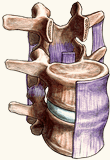About Cervical Myelopathy
Whereas radiculopathy refers to the nerve root, myelopathy denotes a problem with the spinal cord. Cervical myelopathy is a condition caused by compression of the spinal cord in the neck. Compression often occurs in individuals who have a congenitally narrow cervical canal, i.e., their spinal canals are, on average, smaller than normal. Over time, age-related or degenerative changes encroach upon the available space within the spinal canal, leading to compression of the cord.
Diagnosis of Cervical Myelopathy
Diagnosis of cervical myelopathy is sometimes difficult. Patients rarely present with significant pain and symptoms often come on over long periods of time. Symptoms that may help differentiate cervical myelopathy from radiculopathy include numbness in both hands, clumsiness of the hands while manipulating small objects like coins, keys, jewelry, and the like. Problems with balance and an unsteady gait may occur late in the course of the disorder. The necessary finding in treatment of cervical myelopathy is spinal cord compression seen on MRI. This often stems from having spinal degeneration in addition to having a narrow spinal canal.
Surgery for Cervical Myelopathy
The most effective treatment for cervical myelopathy is to surgically widen the spinal canal. Surgery is usually reserved for patients with significant spinal canal narrowing and functional deficits. As with most spine surgeries, there are several procedures to correct this condition. Depending on where and how extensive the spinal cord compression several different surgical options exist.
The goal of surgery is to take pressure off the spinal cord. Cervical fusion may also be recommended to stabilize the spine. Be sure to discuss the risks and benefits of surgery with your doctor before making a final decision regarding treatment.




 Dr. Kwon specializes in treating adult spine disorders. Whether you’re suffering from neck or back pain, Dr. Kwon will provide you with all the information you need to make an informed treatment decision.
Dr. Kwon specializes in treating adult spine disorders. Whether you’re suffering from neck or back pain, Dr. Kwon will provide you with all the information you need to make an informed treatment decision.